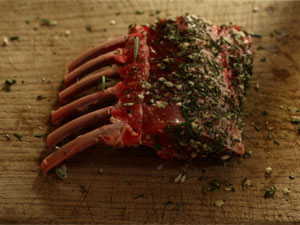For the lamb lovers out there, this is essential reading. Skye Bond, the head chef of Hops and Glory, has told us how to get the best out of a lamb, from cooking the classic roast leg to breadcrumbing and frying the offcuts.
He also fills us in on the unique farm in Devon where he's buying two whole lambs for a special Easter menu. The farm is an important ecological site because the sheep's dung encourages endangered wild dung beetles and kestrels to breed.
Read on about buying the best heritage lamb, and the curious instincts of sheep...
Why is lamb such a traditional Easter food?
It's actually surprisingly difficult to get good lamb at Easter! What we consider a seasonal meat is actually a relic of the Jewish Passover. The sacrificial lamb was roasted and eaten with unleavened bread and bitter herbs. When Jews converted to Christianity, they brought this tradition into the English culinary calendar. In truth, most lamb at this time of year, if it hasn't been frozen and flown in from New Zealand, has been raised over winter indoors and fed on concentrated feed and will have a sickly flavour - your average supermarket lamb will normally fall into one of these categories. Luckily for us, Village Farm in East Portlemouth pasture-feed their sheep all year round, which is unconventional and a lot of work, but is entirely part of their permaculture ethos. The winter dung left by the sheep has seen the resurgence of the endangered winter dung beetles, which in turn has attracted smaller mammals and ultimately the kestrels, which are now breeding there. At this time of year, the best lamb will be found on these less commercial, family-run farms.
Did you have any foodie traditions for Easter growing up?
Honestly, no. My parents were Canadian hippies, we smoked pot and ate chocolate.
You're buying your lamb from a farm in Devon, where is the best place for Londoners to get theirs?
I'm a big advocate of rare-breed sheep. These older heritage breeds have really distinctive characteristics, and each farm has their own way of raising them. The quality and type of forage they provide genuinely carries through in the flavour of the meat. Outside of farmers' markets, the online lamb box scheme is brilliant. Each farm can supply, for around £80, half a heritage lamb butchered how you want and delivered the next day. The supermarkets can't beat this on price or quality. Look for the Herdwicks from Cumbria, raised semi-wild on a diet of heather, bilberries and wild herbs. The meat is lean, dark and gamey and has none of the off-putting 'lamb fat' aroma you get with cheaper meat. Salt marsh lamb is easy to get online too - it's sweet, plump and doesn't need much ageing to get the best out of it. Search online for 'rare breed lamb box', and make some space in the freezer. I would recommend cooking the prime cuts from the loin when they arrive, roasting the leg and freezing the breast, shoulder, shank and any mince for slow-cooking later.
The farm has a 'lead sheep' rather than a sheep dog, what is that exactly?
Sheep are strongly matriarchal. Lambs are taught by their mothers where to shelter and where to forage, and this instinct can be extended to allow a senior member of the flock to lead the rest around the farm as required, rather than chasing them there with a dog! They’re quite canny though - the most senior of the two leaders refuses to take them into the shearing shed.
You're buying two whole lambs for Easter. What are you going to make?
I’ll be grilling as much of it as I can on our Robata grill and generally not mucking about with it. This is going to be about the meat, not the garnish.
Can you tell us some clever ways to use all the cuts?
Cover the offcuts and some diced onion with water and simmer until they fall apart, pick out any white membrane (it’s like rubber, you can’t miss it) and keep what’s left in its own stock. This neutral ragu keeps for ages in the fridge, and can be tarted up and used for anything you like - pie filling, pasta sauce, as a stew, as a base to complement the expensive cuts. You can even breadcrumb it and deep-fry it. And look up a kofte recipe for the mince - you can’t beat it.
How can a novice in the kitchen prepare the perfect lamb dish?
Cook anything along the back from the rump up to the shoulder pink but not too rare. It's gorgeous medium rare when the juices are running and the fat is melted, but anything less is like eating it straight off the butcher’s block. The shanks, the shoulder and the breast need long, moist heat to break them down, but too much liquid will pull the juices out of the meat and leave it feeling a bit fibrous. Better to seal the joint under foil and let it stew in its own stock. The leg is a classic roast but don’t try and be clever and serve it rare. The membrane between the muscles will be gristly - better to give it some time in the oven and then rest it for ages in a bit of foil, then let the muscles relax back down to a sensible temperature.
Perfect Easter Lamb
Skye Bond, the head chef of Hops and Glory, gives us the lowdown!

This article is connected to Hops & Glory
Published Mar 21, 2016
